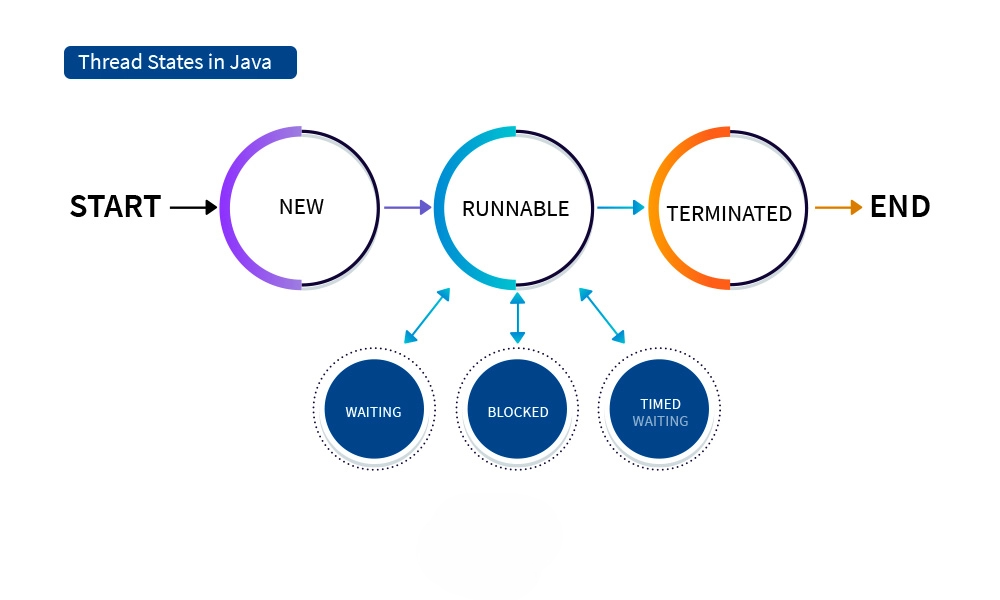
- What is a Thread?
- Lifecycle of a Thread
- Creating Threads in Java
- Extending Thread vs Runnable
- Thread Methods
- Thread Priorities
- Synchronization
- Conclusion
What is a Thread?
In computing, a Thread in Java is the smallest unit of execution within a process. A process is an instance of a program in execution, and it can contain multiple threads that share the same memory space but operate independently. Threads enable multitasking within a single process, allowing different parts of a program to run concurrently. For example, in a web browser, one thread might handle rendering a webpage, while another handles user input or background downloads. This makes applications more responsive and efficient. Threads within the same process share resources such as memory, file handles, and variables, which allows for faster communication and lower overhead compared to using multiple processes Java Training . However, this also introduces complexity. If multiple threads try to access shared data at the same time, it can lead to issues like race conditions or deadlocks, which must be managed using synchronization techniques (e.g., locks, semaphores). Modern operating systems and programming languages provide robust support for multithreading, enabling developers to write concurrent applications for improved performance, especially on multi-core processors. Overall, threads are a powerful tool in software development, essential for building responsive, high-performance applications but they require careful design to avoid concurrency problems.
To Earn Your Java Training Certification, Gain Insights From Leading Web Developer Experts And Advance Your Career With ACTE’s Java Training Today!
Lifecycle of a Thread
In Java, a thread’s lifecycle consists of several well-defined states managed by the JVM:
- New – The thread object is created but has not started yet.
- Runnable – The thread is ready to run and waiting for CPU scheduling Minimum Spanning Tree.
- Running – The thread is executing its run() method.
- Blocked/Waiting – The thread is temporarily inactive, waiting for a resource or signal.
- Timed Waiting – The thread waits for a specific time before resuming.
- Terminated – The thread has completed execution.

These states are controlled through methods like start(), sleep(), wait(), and join().
Creating Threads in Java
Java provides two main ways to create threads:
Extending the Thread Class
You can create a new class that extends java.lang.Thread and GUI Tkinter Module overrides its run() method.
- class MyThread extends Thread {
- public void run() {
- System.out.println(“Thread is running…”);
- }
- }
- public class Main {
- public static void main(String[] args) {
- MyThread t1 = new MyThread();
- t1.start();
- }
- }
Implementing the Runnable Interface
The Runnable interface defines the run() method, which is implemented by the class Reverse C++ Vector .
- class MyRunnable implements Runnable {
- public void run() {
- System.out.println(“Thread via Runnable is running…”);
- }
- }
- public class Main {
- public static void main(String[] args) {
- Thread t1 = new Thread(new MyRunnable());
- t1.start();
- }
- }
Would You Like to Know More About Java Training? Sign Up For Our Java Training Now!
Extending Thread vs Implementing Runnable
Extending Thread
- Single Inheritance Limitation: Since Java supports only single inheritance, extending Thread means the class cannot extend any other class.
- Override run() Method: You define the task by overriding the run() method in the subclass of Thread.
- Simpler Syntax for Basic Tasks: Suitable for quick or simple multi-threading tasks without the need for high flexibility.
- Tight Coupling of Logic and Thread: The thread logic and execution are bundled into one class, reducing modularity Java Training.
- Creating and Starting a Thread: You create an object of the subclass and call start() to begin execution.
- Allows Class Inheritance: Since you’re only implementing an interface, your class can still extend another class, providing more design flexibility.
- Implement run() Method: You define the task by implementing the run() method from the Runnable interface.
- Better Separation of Concerns: The task logic is separated from the thread creation and control, promoting clean and modular code.
- Code Reusability: Runnable tasks are independent of thread execution, Data Structures & Algorithms making them more reusable and easier to test.
- Creating and Starting a Thread: You pass the Runnable instance to a Thread object and call start():
Implementing Runnable
Thread Methods
Java’s Thread class provides many methods to control execution:
- start() – Starts the thread and invokes run().
- run() – Contains the code to execute.
- sleep(ms) – Pauses thread execution.
- join() – Waits for another thread to finish.
- interrupt() – Signals a thread to stop.
- isAlive() – Checks if a thread is still running.
- setPriority(int) – Changes thread priority.
- getName() / setName(String) – Gets or sets thread name.
Thread Priorities
Java threads have priorities from 1 (MIN_PRIORITY) to 10 (MAX_PRIORITY), with the default being 5 (NORM_PRIORITY). Thread scheduling is handled by the JVM and the operating system. While higher priority may suggest faster execution, it is not guaranteed because scheduling depends on the OS. In Java, thread priority is a mechanism that helps the thread Paging in Operating Systems scheduler decide the order in which threads are executed. Each thread is assigned a priority value, Thread in Java which is an integer ranging from 1 (Thread.MIN_PRIORITY) to 10 (Thread.MAX_PRIORITY). The default priority is 5 (Thread.NORM_PRIORITY). Thread priorities act as hints to the thread scheduler, suggesting which threads are more important. In theory, a thread with a higher priority should get more CPU time than one with a lower priority. However, thread scheduling is platform-dependent, and priorities may not always be strictly enforced, especially on modern operating systems where time-slicing and fairness policies are in place.
Are You Interested in Learning More About FullStack With Java Training? Sign Up For Our Java Training Today!
Synchronization
When multiple threads access shared resources, race conditions can occur. Synchronization ensures that only one thread accesses a resource at a time IPO Cycle.
Example:
- class Counter {
- int count = 0;
- synchronized void increment() {
- count++;
- }
- }

Types of synchronization in Java:
- Synchronized methods – The entire method is locked.
- Synchronized blocks – Only a specific code block is locked.
- Static synchronization – Locks at the class level.
Preparing for Java Job Interviews? Have a Look at Our Blog on Java Training Interview Questions and Answers To Ace Your Interview!
Conclusion
Threads in Java are a powerful feature for executing multiple tasks concurrently, improving performance, and enabling responsive applications. However, with great power comes great responsibility. Developers must handle synchronization, communication, and resource sharing carefully to avoid bugs like race conditions and deadlocks. By mastering thread creation, lifecycle management, synchronization techniques, and concurrency utilities, Java developers can build high-performing, scalable, and responsive applications. Thread priorities in Java offer a way to suggest the relative importance of threads to the CPU scheduler. By assigning values between 1 and 10, developers can influence how system resources are allocated among concurrent threads Java Training . However, since thread scheduling is platform-dependent, priority settings are not always strictly followed. Therefore, while priorities can be useful for tuning performance in specific cases, they should not be relied upon for critical application logic. Instead, focus on well-designed multithreading practices like proper synchronization, task separation, and using concurrency utilities. When used appropriately, thread priorities can help improve responsiveness and efficiency in multithreaded applications.





